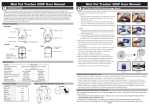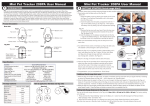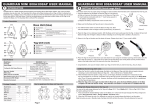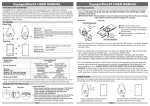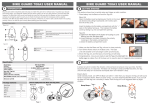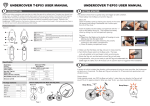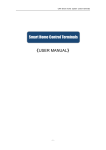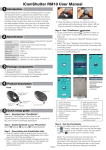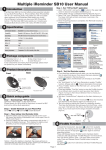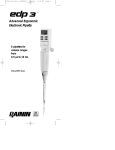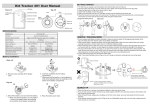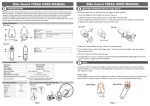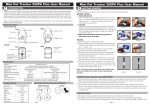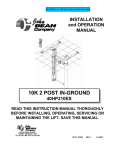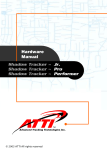Download PetFinder LT-904 User Manual
Transcript
PetFinder LT-904 User Manual 1 2 GETTING STARTED (Out-of-range Alert) INTRODUCTION The new PetFinder LT-904 is much like the original Petrek LT-902 which was the first generation of our small RF based trackers with a silicone case allowing you to attach onto most small collars with ease. With two proximity alarm distance settings to choose from, you are able to set the alerting distance at either 40 metres or 80 metres. When the pet wanders up to the selected distance alert setting, the owner will get a warning alarm alerting them to check for their pet’s location. If in the unfortunate case of losing sight of your pet, the remote base unit can track your pet down to a range of up to 100 metres by showing the strongest transmitter signal as you walk and search areas you feel your pet might have wandered to. Note: In a direct line of sight, the tracker may work up to 200m but we have tested in most New Zealand/Australia situations with varying surroundings which showed us 100m is the maximum reliable tracking range the PetFinder LT-904 gets up to. Product Description Remote Base Unit Front Back Buzzer Bottom cover Top cover LED FindMe button Battery cover Power switch Ring Attachment Tag Unit Back Front Top cover Buzzer Hanging hole for strap Bottom cover Power Switch (Hold button over 3 seconds to turn ON/OFF) Specifications Function Communication Standard Search Range Alarm Distance Remote Base unit/Tag unit Battery Type Battery Life Time with Standby Beep Sound (at 10cm/3.9inch) Weight Dimension (L/W/H) Working Environment Search & Alarm Digital 2.4 GHz RF (Frequency range: 2.40 - 2.48MHz) 0~100m (*Distance will vary depending on terrain and other factors.) Near: 40 ± 10m, Far: 80 ± 10m Remote base unit (LT-904A) Tag unit (LT-904B) CR2032x1 CR2032x1 30 days (8 hrs) 90 days (8 hrs) How to apply/wear the Remote Base unit and Tag units Remote base unit Tag Unit Batteries Velcro strap PetFinder LT-904 Remote Base Unit 1 set Hook 1 set 1 set User manual 1 set Tag Unit a. Remove the top cover with your hand. Force the top cover to slide from its mounted position towards the top of the Tag. (as figure 3 & 4) b. Insert the battery into the battery compartment with the ”-” battery facing up. Then replace the top cover by sliding it down into the compartment.(Figure 5) 2. Make sure that the Remote base and Tag units are in close proximity. (next to each other) 3. Turn ON the power switch on both the Remote base (Figure 6) and Tag units. Both units will establish a link and begin to blink synchronously. 4. Place the Tag unit in a stationary location. With the Remote base unit in hand, walk away from the Tag. At about 40 metres, both Remote base and Tag units will begin to beep and flash, indicating an out-of-range alert condition. (Figure 7) 5. Return to the Tag unit location and the alerts will cease. 6. Place the Tag into the provided Silicone case (Figure 8) and attach the case using the ventilation openings at the bottom onto the pet collar . If the collar is too wide to fit into the Silicone case vents please use the provided Velcro strap on the larger collar and fit the case onto the strap. (As picture 9) 7. Congratulations, you have just completed the Quick Setup! Figure 3 Figure 4 Figure 5 Figure 6 Reminder Power Switch Tag Unit Remote Base unit 40 metres Figure 7 Figure 8 Figure 9 Tag Unit 1. When the Tag unit is within the safe range, the lights on the Remote base and Tag units blink dimly at regular intervals, indicating an active link between Remote base and Tag units – this is referred to as “Standby Mode”. 2. When the Remote base loses the signal to a Tag unit (i.e. out-of-range), the Remote base will beep for 10 seconds and the Tag will beep for 15 seconds. If the Remote base unit and the Tag unit are not reunited, both units go into Sleep Mode after 10 and 15 seconds respectively. However, the Remote base unit will intermittently beep until the link is re-established with the Tag unit. 3. When the Tag unit is once again reunited with the Remote base unit, press the Search button on the Remote base unit (Remote base unit will enter Search mode). Press the Remote base unit button a second time to re-establish the link. Setting Safe Range distances for the Tag unit 1 set You can set the safe range distances for the Tag unit to Near (40 ± 10 metres), or Far (80 ± 10 metres) the factory setting is 40 metres. 1. Press and hold the “Search/Setting” button on the Remote base unit - notice how the LED changes from Red to Green. Red represents “Near” and Green “Far”. 2. When the LED shows the color (i.e. distance) you want to set, simply release the button to set the option. Note: that when you are in Standby mode, the Remote base unit LED will blink the color of the safe distance that you set. CR2032x2 Sets 1 set Silicon Sleeve This section shows how to quickly setup and trigger an alert condition when the Remote base unit steps away from the Tag unit. 1. Install the battery to Remote Base unit and Tag unit Remote base unit a. Open the battery cover by applying pressure with your thumb on the cover (Figure 1) and sliding it backwards until it clicks open; then lift off the cover. Figure 1 Figure 2 b. Insert the battery with the “+” sign on the battery facing up (Figure 2). Then replace the battery cover by sliding it up into compartment opening. Additional Out-of-range Alert notes 90db ± 3 db 80db ± 3 db 9.5g (0.34oz.) 4.2g (0.15oz.) 2.42x1.42x0.46inch 1.5x1x0.42inch Temperature: 5℃~40℃、humidity:20%~80% Package Contents Model Name PetFinder LT-904 User Manual Page 1 Page 2 PetFinder LT-904 User Manual 3 PetFinder LT-904 User Manual 5 Searching for a misplaced Tag Unit When a tagged item is misplaced, you can use the Remote base unit to search for it, if it is within a 300 ft / 100 m (line of sight) radius. Try this first in an open area (e.g. large room, or in your yard). Press once 1. Take the Remote base unit and stand apart from the Tag unit (about 15-20 ft). On the Base unit, press the Search button once. The Remote Base unit will begin to chirp and the Tag unit will begin to beep. 2. Before searching, you must first calibrate the Base to the current terrain and environment. Hold the Remote Base unit in front of you at chest level, and scan the area slowly in a circular direction, from right to left for 360° (a) and again from left to right (b), one 360° turn in 3-4 seconds. Note: You don’t have to scan a full 360°; you can use a narrower search angle (e.g. 180°). Note: If the “Direction Indicator” illuminates green on the Base unit during this calibration process, it does not yet indicate the Tag unit’s direction. 3. Next, begin the search by slowly scanning a third time from right to left (c). The “Direction Indicator” on the Remote base unit will illuminate (green) when it establishes the direction of the tagged item location. a Calibrate b c Search 4. Move in the direction of the Tag unit. As you approach the Tag unit, the frequency of the chirping and blinking (LED) on the Remote base unit will increase. 5. If the Tag unit is hidden (e.g. in a pocket), you can MUTE the Remote Base unit by holding down the button on the Remote Base unit, allowing you to follow the audible Tag beep to pin-point the Tag unit’s location. Additional Search Function Information 1. In an enclosed room, the green direction indicator may show a false tag location. This is because the Rf signals may be reflecting off of walls from different angles. In this case, hold down the button on the Remote base unit to mute the Base chirping and follow the Tag beep audible to pin-point its location. 2. This product uses RF signals which can penetrate walls and floors - however, these signals are also sometimes affected by materials and terrain, such as bodies of water, metal/wire fences, concrete walls, and crowds (e.g. in malls, amusement parks) - for children, it is important to teach them to move to open areas when lost to assure optimal conditions for searching from the Remote Base unit. 4 Panic call from Tag Unit The Tag units have an additional function of allowing a child or elderly dependent to call the Remote base unit for help. To activate Panic Alert, press and hold down the panic button on the Tag unit; the Remote Base unit will beep and blink brightly. When the Tag button is released, the Panic alert ceases. Page 3 Q. In search mode, why does the Remote base unit show a false direction or several different directions? A. The Remote base unit collects and compares RF signal strength from the Tag unit to determine location. However, when the Tag unit is already very close to the Remote base unit, the signals can appear emanating from several directions. This can also occur when both units are in an enclosed environment, which causes signal reflection off of walls from different directions, indicating a false location. If this is the case, you can mute the Remote base unit, and simply follow the audio beep issued by the Tag unit during search mode. Q. Why does the Remote base unit occasionally indicate a false direction? A. This is also caused by the reflection or blockage of the signal. Signal reflection from walls or wire fences sometimes may indicate a false location. A body of water (e.g. fish tank) for even people may block the signal and weaker reflected signals from surrounding metal objects may indicate a false direction. To remedy this problem, try adjusting your position, wait for the “Status Indicators” to settle and try your search again. Q. What can cause a false out-of-range alarm? A. False alarms are caused by: - Remote base and Tag units being too close to each other. - Low battery charge on Remote base or Tag units - Either the Remote base or Tag unit being placed in a pocket with other items, blocking the signals. Q. Why is the range alarm distance not consistent? A. Because radio signal strength and signal reflection are affected by the environment and terrain, users may need to adjust the out-of-range distances to compensate for environmental factors. Q. No Alert when the Tag unit is out of range A. - Check for low battery on both units - Check the out-of-range distance - if the Tag unit is set for “Far”, you may need a greater distance before setting off an Alert. 6 180-360 Frequently Asked Questions Warnings and Important Information 1. The Tag units are water-repellent, but not waterproof! Keep the device dry. Precipitation, humidity, and all types of liquids or moisture can contain minerals that may corrode electronic circuits. If your unit gets wet, remove the battery, and allow the unit to dry completely before replacing it. 2. If you want to use the device during air flight, please comply with the air safety regulations for each respective country. 3. We reserve the right to change the hardware/software specifications and designs, as well as the information in the manuals, at any time without prior notice. 4. Proper operating temperatures for this product are between 40˚F ~104˚F (5˚C~40˚C). Proper storage Temperatures are between -4˚F~185˚F (-20˚C~85˚C). 5. Under low battery charge conditions, both Remote base and Tag will alert with a beep every 2 minutes - in this case, replace batteries immediately. Low battery conditions may result in unpredictable product behavior, such as low alert volume and false readings. To save battery charge, turn off both units when appropriate (e.g. evenings at home). 6. The batteries provided in this product should be disposed of properly according to national or regional recycling regulations - contact local authorities for more information. Warning: Do not expose the batteries to fire or heat - this may result in danger from explosions. Federal Communication Commission Interference Statement This equipment has been tested and improved to comply with the limits of a Class B digital device, pursuant to Part 15 of the FCC Rules. These limits are designed to provide reasonable protection against harmful interference in a residential installation. This FCC Certifications equipment generates, uses and can radiate radio frequency energy, if installed and used not in accordance with the instructions, may cause harmful interference to radio communications. However, there is no guarantee that interference will not occur in a particular installation. If this equipment does cause harmful interference to radio or television reception, which can be determinedly turning the equipment off and on, the user is encouraged to try to correct the interference by one of the following measures: ■ Reorient or relocate the receiving antenna. ■ Increase the separation between the equipment and receiver. ■ Connect the equipment into an outlet on a circuit different from that to which the receiver is connected. ■ Consult the dealer or an experienced radio/TV technician for help. This device complies with Part 15 of the FCC Rules. Operation is subject to the following two conditions: (1) This device may not cause harmful interference, and (2) this device must accept an interference received, including interference that may cause undesired operation. FCC Caution: Any changes or modifications are not expressly approved by the party responsible for compliance which could void the user's authority to operate this equipment. EU / RCM Declaration Conformity This product is carrying the RCM and CE-Mark in accordance with the related European / Australia / New Zealand Directives. Page 4


